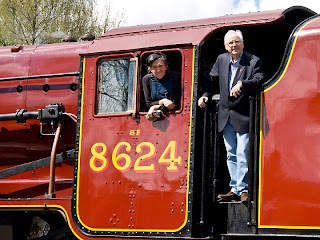It's hard for me to believe that this is the fifth 'Review of the Year' I've produced since starting this blog. It's even harder to believe I've really had all these wonderful experiences. Yes, I think I've been exceptionally fortunate. Forgive me if I draw attention only to the highlights. The year has had its bad bits and boring bits but I'm sure we don't want to dwell on those.
I've grouped the activities into 'TRAVEL', 'RAILWAYS' and a little bit on 'BREWOOD'.
TRAVEL< /p>
My Mother was always an intrepid traveller, although her opportunities were rather limited. I've only developed the taste for it in the last few years, but I've tried to make up for lost time.
Java, Bali, Sarawak, Sabah, Kuala Lumpur

When I discovered that the 'Pandaw' company had started river cruises in Borneo, the idea immediately appealed and, through the Travel Club Wexas, arrangements were made. To make best use of the cost of flying to the Far East, we "topped and tailed" the river trip with other visits. For some time, I'd wanted to visit Borobudur - the largest Buddhist monument in South East Asia. This is situated on the island of Java, which is part of Indonesia. After Borobudur, I would see a little of Yogjakarta before flying to the Indonesian island of Bali. Then on to Sarawak in Borneo, to look at the city of Kuching before joining the river cruise at Sibu. After exploring the Rajang River, I would fly on to Sabah for a couple of nights before flying to Kuala Lumpur. After a couple of days exploring the city, I would return to England.
If that sounds exhausting, it was, but it was also one of the most stimulating trips I've undertaken. Click for detailed reports on the trip
The Arctic

I'd enjoyed my earlier trip to the Antarctic Peninsula, so I decided to visit the 'Other End' of our world on the luxurious exploration ship 'Prince Albert II', operated by Silversea. I flew via Oslo to Tromso where I joined the ship which headed north. We made one stop on mainland Norway at Nordkapp, then headed further north to the group of islands known as Svalbard. We virtually circumnavigated the main island, Spitsbergen, getting as far as 81 degrees north before ending our cruise at the town of Longyearbyen.
This trip provided a host of unforgettable memories. Click for detailed reports on the trip
Burma

On this visit, I took the 'Road to Mandalay' cruise ship north from Mandalay to Bhamo. It was good to see my friends on the ship again and we had some marvellous experiences on our various trips ashore. We visited a number of schools where 'Road to Mandalay' distributed stationery and we also cruised past a number of other schools where the pupils were lined up on the river bank to say 'Thank You' for stationery delivered by smaller boats. The trip ended at magical Bagan. During a road trip to Mount Popa, I was invited to participate in the official opening ceremony of a new school building at Htee Pu - this was a very moving experience for me.
Click for detailed reports on the trip
RAILWAYS
During 2010, I added some more technical pieces to the blog on railway signalling describing the arrangements at Spring Vale Sidings and Princes End. Both these boxes are long gone but many of the principles described are still in use. All the articles on railway signalling are here.
At the request of my friend Phil, I started the lengthy process of transcribing traffic notes I made at Sedgeley Junction in 1962/3. Phil also organised a splendid slideshow attended by some invited fans of the South Stafford Line.
During my visit to Indonesia, I snatched a little time to look at the railway system in Java - see Part 1 and Part 2. Returning via Kuala Lumpur, I also made a few journeys on the Mass Transit system and the KTM suburban railways. There's a brief report here.
 Jan, on Thomas, collects the Single Line Staff leaving Shackerstone (photo: Sam Brandist)
Jan, on Thomas, collects the Single Line Staff leaving Shackerstone (photo: Sam Brandist)
'Thomas' celebrated his 65th birthday in 2010. I was involved at Shackerstone on a number of dates, but I missed the 'official' birthday celebrations on 1st May 2010 due to a prior engagement. See reports (part 1) and (part 2).
The 'prior engagement' was driving the '8F' at Peak Rail on the day the turntable was inaugurated by Pete Waterman.
 Jan Ford and Pete Waterman on the '8F' after turning (Photo: Sheila Rayson)
Jan Ford and Pete Waterman on the '8F' after turning (Photo: Sheila Rayson)
On 15th May 2010, I travelled to Liverpool by rail for the OLCO Annual General Meeting. There's a brief report (with pictures) here.
On the 27th June, 2010 I reluctantly had to declare 68013 a failure at Peak Rail after the link in the dome between the regulator handle and the regulator valve became detached. I finished the day as supernumary on 'Penyghent'. There's a report here.
The 'Anything Goes' weekend at Peak Rail featured two-train working with the passenger train and a demonstration freight train. This time, 68013 behaved but there were one or two problems with the diesel locomotives as the report describes.

'Lionsmeet' was held at Kinver on 31st July. My report is here.

My first 'turn' on a 'Light Prairie' came on 22nd August at Shackerstone. There's a short report here.
My trip to Burma included a train ride from Katha to Naba and back. I travelled in the locomotive cab both ways. See reports 'Cab Ride from Katha' and 'Cab Ride back to Katha'.

During the year, I had a number of turns on the DMU at Shackerstone but the booked turn on 25-Sep-2010 was changed into conductor driver on a visiting 'Class 33'. I got to drive two visiting 'Class 33' during the day so I was quite happy. There's a report here.

The 'Planet' replica was in service at the Museum of Science and Industry in Manchester throughout the year and I had a number of driving turns. To celebrate the 180th anniversary of the opening of the Liverpool and Manchester Railway, 'Planet' was joined by the 'Rocket' replica and train. I was rostered as driver on the 19th September and there's a report here.
On the 2nd October at Shackerstone, I had a very pleasant day on the visiting Pannier Tank 5786. These are capable, versatile engines and, as my friend John likes to remind me (after I used the phrase on a railway video) "You can do anything with a Pannier'". More pictures.
In December, I did a couple of 'Santa Special' days at Peak Rail (see report).
BREWOOD
During the year, I've spent a fair bit of time in the Small Barn used by Ford Electronics where I work.
Brewood Hall is bit like the Forth Bridge in that maintenance or improvement work never ceases. In 2010, the new oak door to the Ice House and the new oak double gates to the yard adjacent to the Big Barn were installed. Then I discovered that the wooden main gates at the front of the house were decaying quite badly so I'm trying to arrange repair of these. The small brick shelter for the Buddha image in the garden has been completed, replacing the tent-like structure perviously in use. Inside the house, the list of things to do keeps extending.
On 21st July 2010, the ladies of Inner Wheel visited for a 'Faith Supper' and a short tour of the principal rooms (see report).
In 2010, Barnfield Sandbeds in Brewood became a public open space. High-quality sand was extracted from the 14-acre site until around 1970, after which nature reclaimed it. South Staffordshire Council, in conjunction with Friends of Barnfield Sandbeds have done a marvellous job. My pictures are here.
Earlier reviews:


















